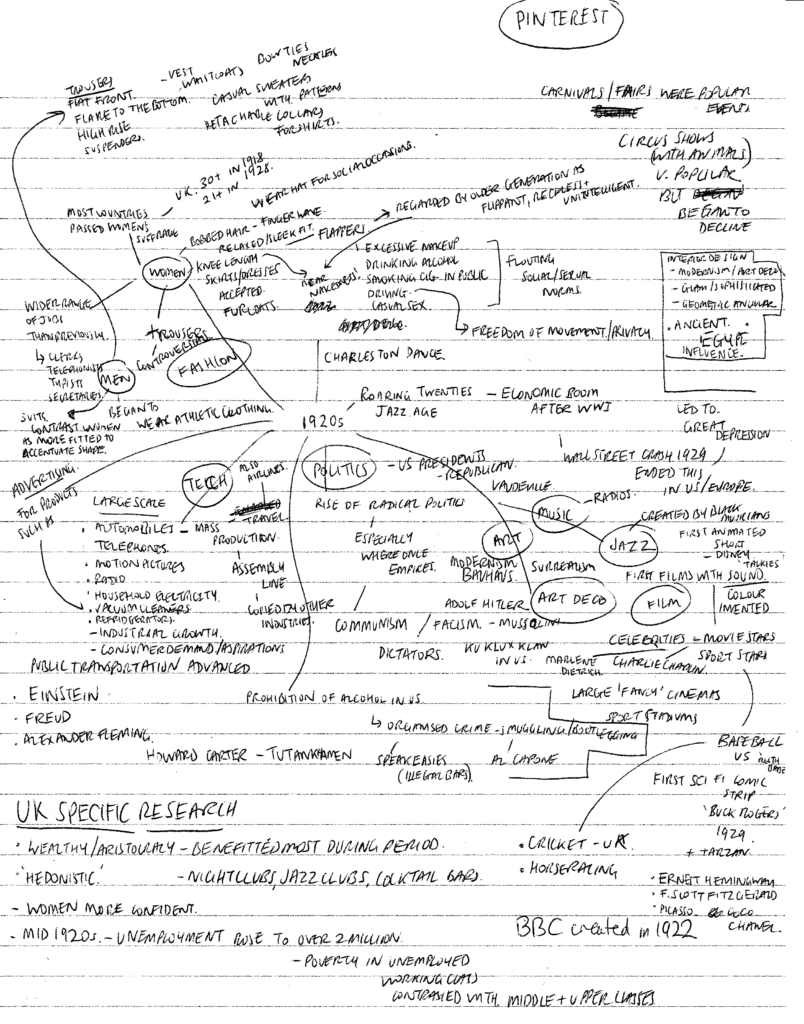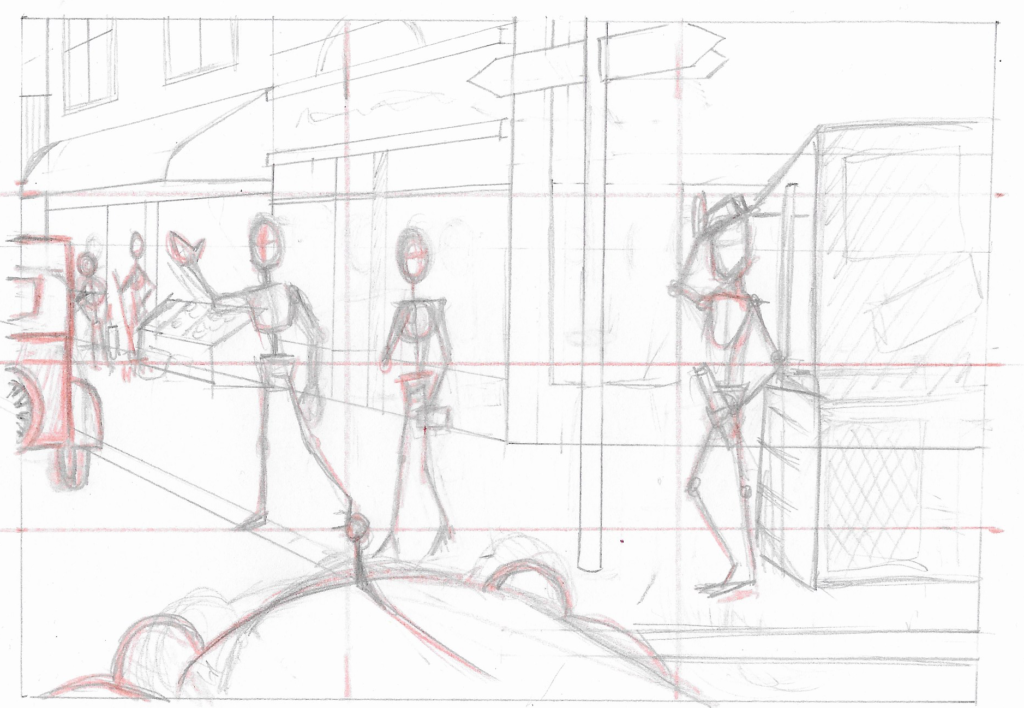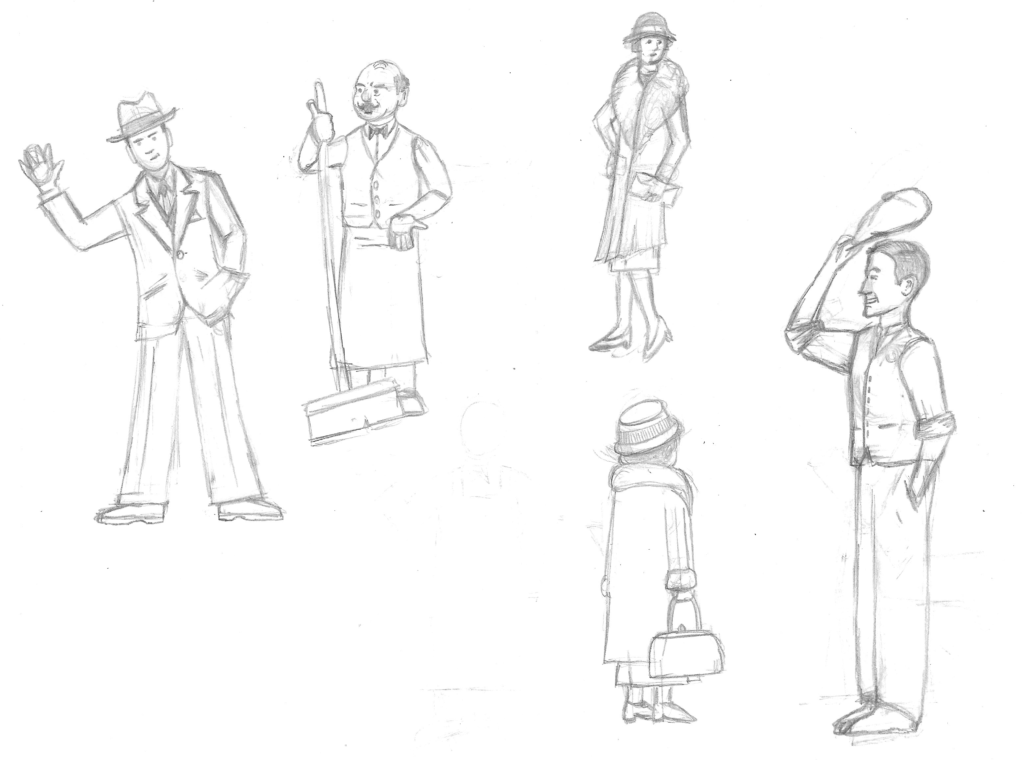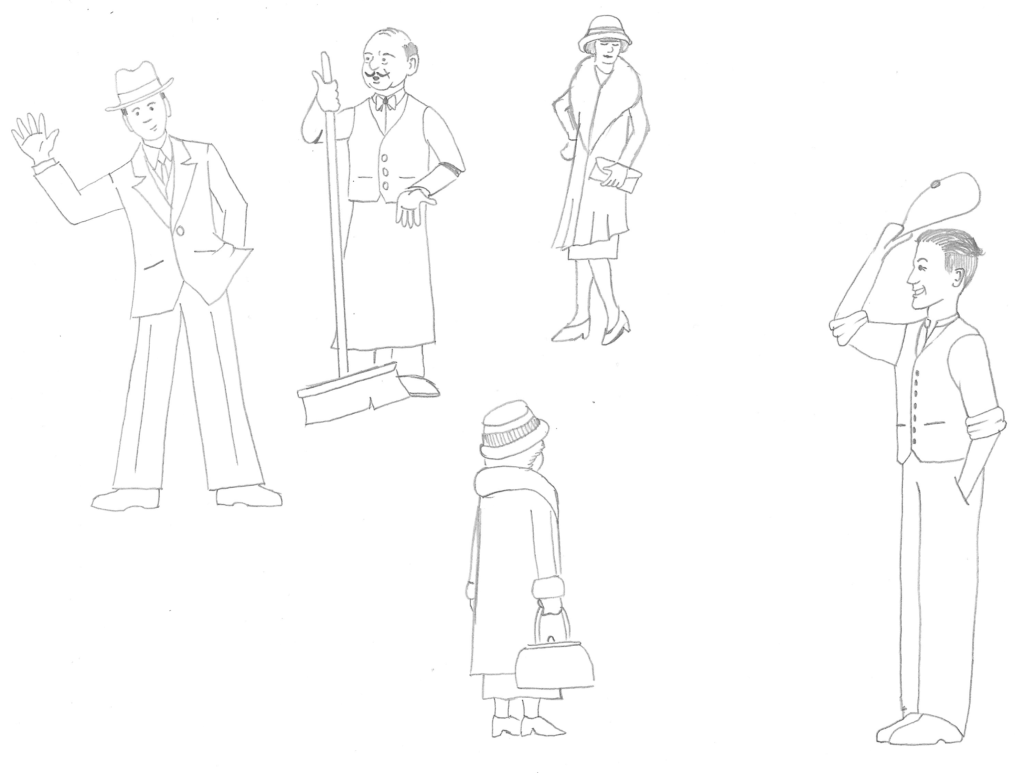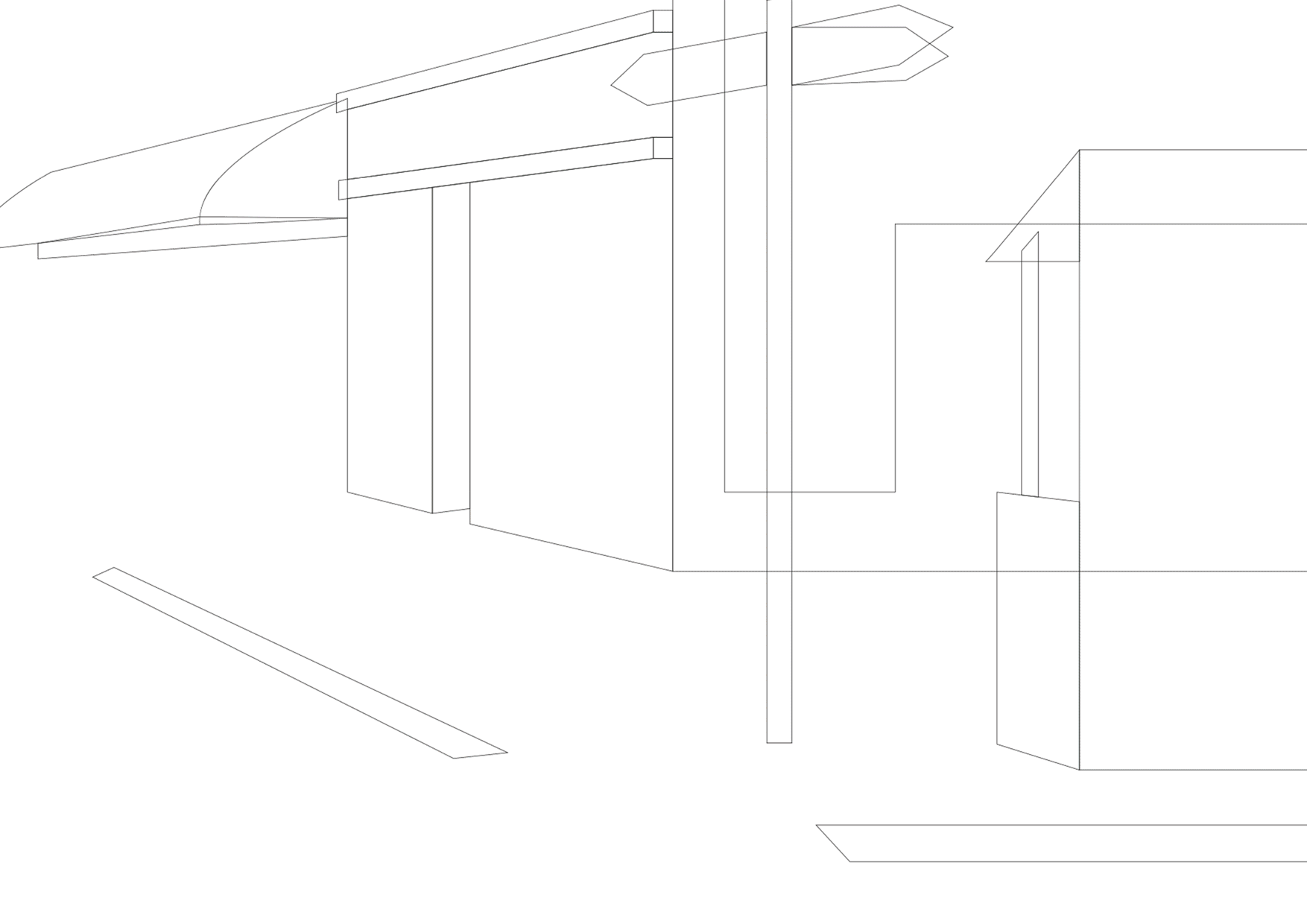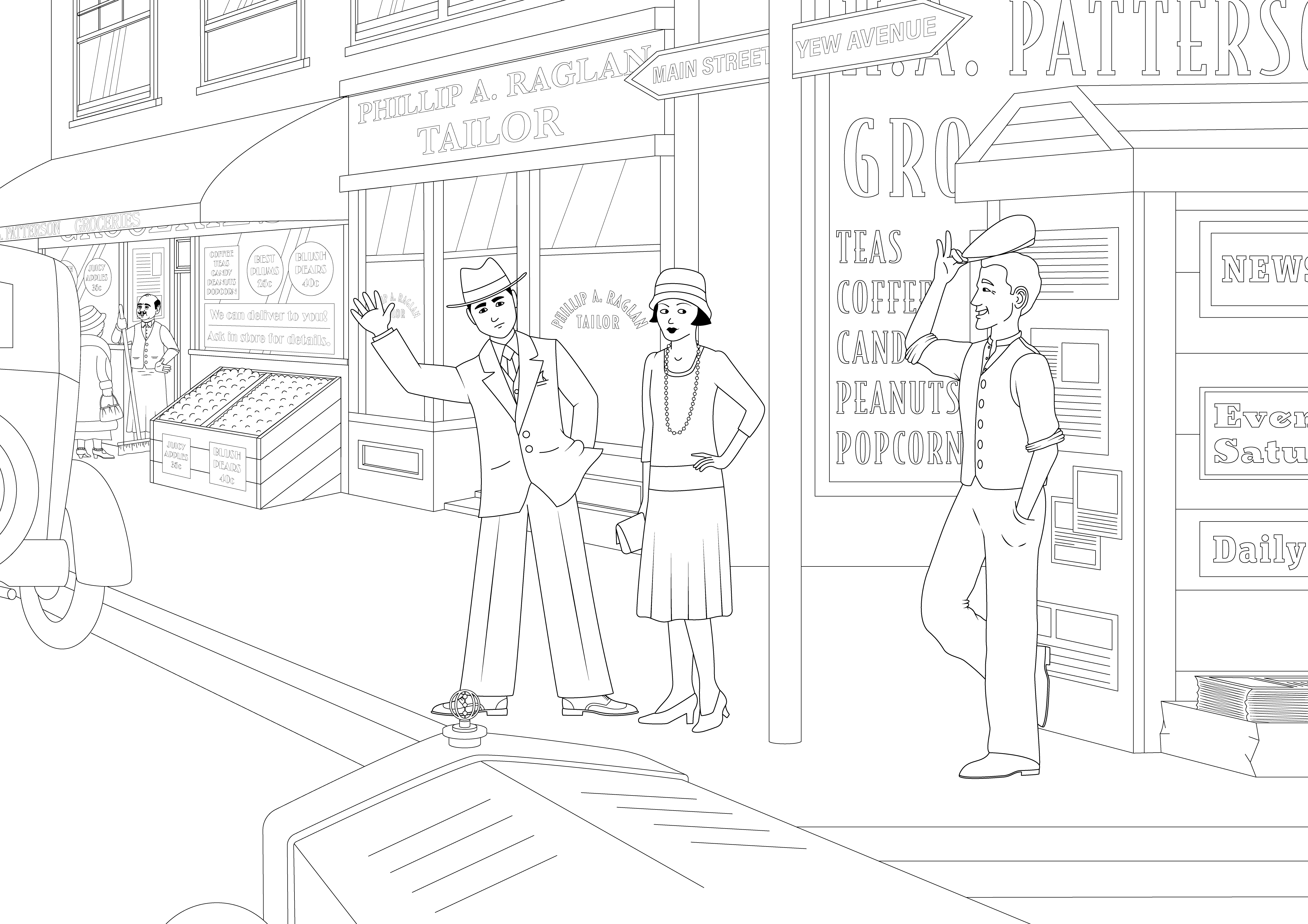Brief
Collect as much reference as you can find from a specific time period or decade. This could be the 1850s, the 1940s, the 1970s – whichever appeals to you to do some visual research. Be as broad as possible in your online image sourcing. Look for images you find interesting that might contribute to your drawing. Also spend some time reading about your chosen period and then start honing your image searches from that information.
Organise your reference material and information into these categories:
- People and clothes
- Architecture and interiors (buildings, churches, railway stations, office blocks, cinemas, etc)
- Design (posters, books, typography, advertising)
- Transport/engineering (horses, cars, trains, planes, etc)
- Popular culture (classical music, pop bands, theatre, films, TV programmes, sports, etc)
Now make a single “landscape” format illustration on a sheet of A3 card or paper of a couple of people standing on a street corner surrounded by the typical architecture, fashion and objects of your chosen decade to give a reader an idea of the time and place. Your drawing can be black and white or colour, but try to make it a detailed picture using lots of reference sources.
Write a short review of your chosen time period from a visual perspective. Describe the characteristics that typify the decade and the ideas and visual trends that were prevalent at this time. It may be useful to look both at what preceded and followed your chosen decade to gain a sense of the broader context of this era.
Research
After reading the brief for this exercise, I was instantly reminded of an almost identical exercise I had to complete for Key Steps in Illustration, which I spent an excessively long amount of time working on! For that exercise I researched and depicted a household scene from the 1950s. Although I was tempted to revisit the same period, instead I selected the 1920s. This was partly influenced by the fact I have recently been watching the TV series Peaky Blinders and Downton Abbey, which are both set around that time (although in completely contrasting settings), so I felt I had the benefit of having some reliable visual information from the era already stored in my mind.
Before looking for any specific visual references, I decided to read about my chosen period to gain some contextual knowledge. I compiled some of the information into a mind-map.
I then proceeded to begin carrying out some visual research. I found there was a wealth of photographs of fashion from the 1920s, but some of the other headings were less easy to find reference material for, when I compared this to my research for the 1950s from the previous unit. I found Pinterest was not particularly helpful for this exercise, although I did endeavour to find some images that were quite relevant, I was not very successful. I also wanted to be sure that these were truly from that time period as it is not always easy to validate this on sites such as Pinterest. After further perseverance, I abandoned Pinterest and moved onto finding other sources.
Along with those images that accompanied the initial textual research I had carried out, I found Google Images and Getty Images Gallery to have the most useful visual reference for this exercise. I used this visual research to gain an overall visual insight into the time period, rather than looking for specific images of reference, which I felt would be more beneficial to do as and when required during the creation of my illustration.
Ideas for Illustration
I was quite apprehensive about this exercise as I very rarely draw buildings and have absolutely no experience in drawing cars or other vehicles. However, the factor that caused me extreme levels of frustration was perspective, which I have never learnt or understood clearly. The fact that the illustration was to be based on ‘a street corner’ filled me with dread! I decided to begin by drawing some very rough concepts of potential compositions.
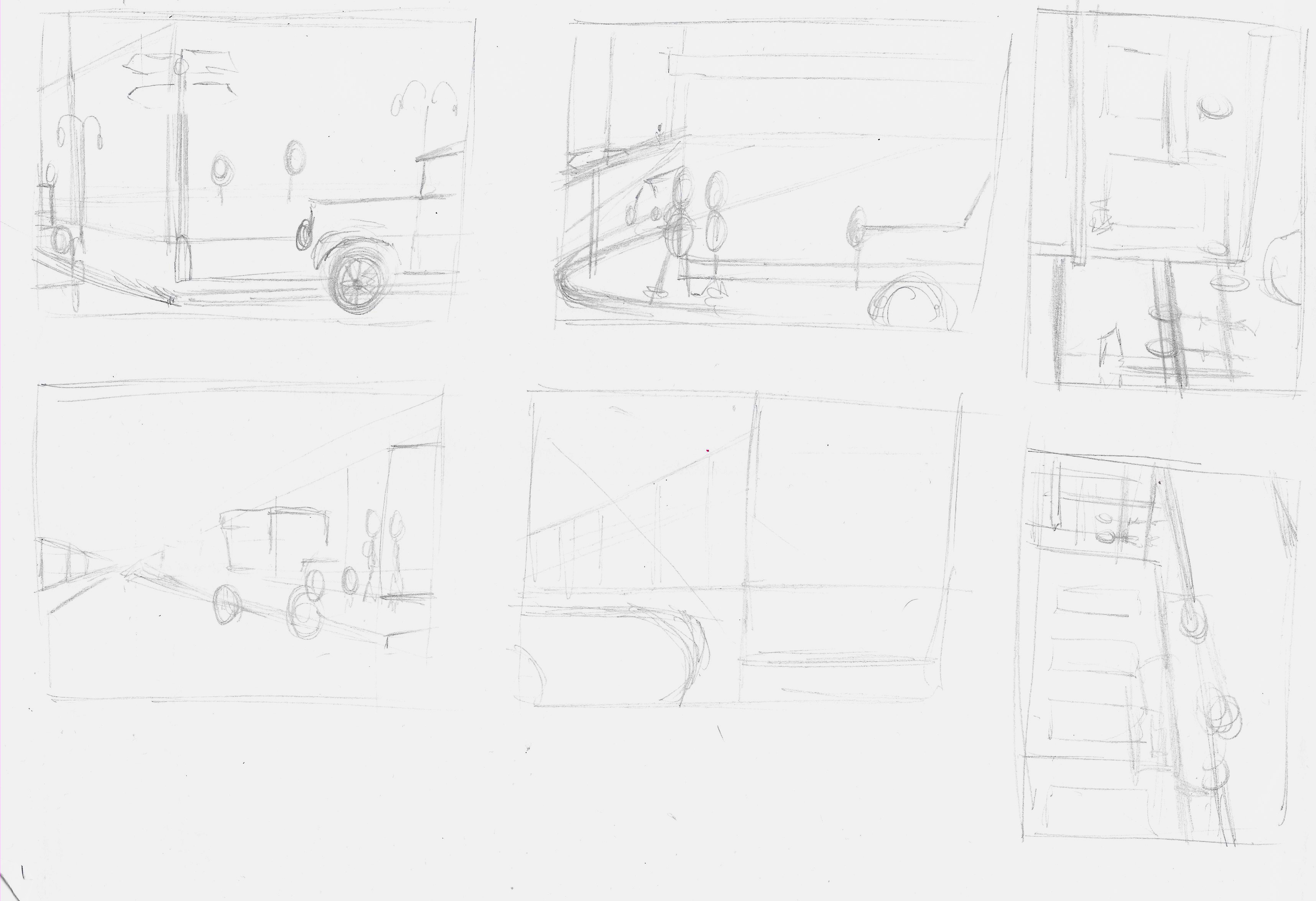
I was not very inspired by my attempts and began to get quite worked up about not understanding perspective, so decided to try and do something about it. I found some very useful videos on Youtube by an artist called Tom McPherson, which went some way to calming me down! (I also decided to purchase the book Perspective! For Comic Book Artists by David Chelsea, which I began to read through alongside doing the exercise).
Eventually I somehow managed to come up with an idea for the illustration that I was fairly happy with.
My next issue was that I had created the above sketch at a very small scale and I was unconvinced that I would be able to reproduce it at A3 size as requested in the brief. I had already spent so much time getting to this point that I decided to scan the image into Illustrator on an A3 artboard and work digitally. I realise this was probably not the right thing to do, but at that point I honestly do not think I would have been able to create anything worthwhile on an A3 piece of paper.
I sketched out the character designs and then did cleaner versions using a light-box before also uploading these to Illustrator to work from.
Working in Illustrator
The process of creating the illustration in Illustrator can be seen below.
With regards to reference images, as previously stated, I found it most helpful to search for certain terms, e.g. ‘1920s women’s shoes’ as and when required, as I could be more specific and thus retrieved much more relevant results.
Once I had begun to grasp a basic concept of perspective, I am not ashamed to say that I genuinely found it almost like magic – I was so convinced that the lines would be skew-whiff, but when I committed to the perspective guides I had added and viewed the image as a whole…it did not fail to impress me every time!
I also learnt how to use the Perspective Grid tool in Illustrator for placing the text in perspective, which, yet again, absolutely fascinated me.
Final Illustration
The ‘final’ A3 illustration can be seen below.
I really had to force myself to stop working on it due to time constraints, but felt I had reached an acceptable point in the development. If possible, before assessment, I would like to return to the illustration as there are still many details I could have added, such as:
- more detail/texture on the road and pavement
- lines on the awning over the grocers
- a person in the window above the grocers
- a tree/foliage behind the grocers
- more detail on the lamp post
- brickwork detail on the buildings
- texture detail on the newspaper stand
I would also like to experiment with adding tone and colour. Additionally the positioning of the emblem on the car at the front of the composition is obscured due to it overlapping the man’s shoe, which I did not feel was very aesthetically pleasing.
Final Thoughts
This exercise caused me many mini-melt-downs and took much longer than I had anticipated (but also semi-expected it from my experience in the similar exercise from Key Steps in Illustration). I was slightly disappointed that I was unable to create my illustration on paper rather than digitally, but I was genuinely quite impressed and surprised that I managed to come up with the final illustration I did, considering I was really at a loss at the start of this exercise.
Although I spent much of the time feeling frustrated, I learnt a great deal from this exercise and, in the end, found it an extremely beneficial challenge. I felt I was already quite good at collecting relevant reference images for my work, so I believe I gained much more in other aspects. As previously stated, I would like to return to this exercise at a later date to make the additions listed.
The 1920s – A Short Review
Some times referred to as the Roaring Twenties, the decade began with an economic boom after the end of the First World War. There was increasing divide between the rich and poor, with the aristocracy and wealthy benefitting during the period, whilst unemployment rose for the working class. Across the world there was a rise in more radical politics such as Fascism and Communism, with dictators rising up in prominence.
There were significant technological and engineering inventions/developments such as the radio, motion pictures, electricity in homes and automobiles. The mass production of the latter influenced industry and completely changed the sector. Many people moved from the country to the cities to work in factories.
Some women became more ‘free’ in terms of fashion, hair and behaviour (sometimes referred to as ‘flappers’) – although this was all generally frowned on by the majority of society, particularly the older generation. Nightclubs and ‘speakeasies’ became particular haunts for the younger generation (the latter were illegal bars in the US where alcohol was prohibited). Some women (of a certain social class and status) were finally allowed to vote in the late 1920s.
Howard Carter was part of the team that discovered Tutankhamon’s tomb, which led to people becoming keen on with having Egyptian inspired interior design. Home decor, for those with money, was also influenced by Modernism and Art Deco, with an emphasis on glamour and sophistication using angular, geometric shapes.
The art movements of the 1920s included Art Deco, Surrealism, Modernism and Bauhaus. One of the most important musical genres to come to the forefront during the period was Jazz.
The 1920s were capped by the Wall Street Crash in 1929, which ended the decade of prosperity in the US and Europe, and resulted in the Great Depression.
Post Script Note
I thought it would interesting to reflect back on the similar aforementioned exercise from Key Steps in Illustration and, even in my often very self-critical opinion, I was impressed at how much I have progressed in the past year both in terms of drawing human figures and my newly acquired (novice) skills in perspective.
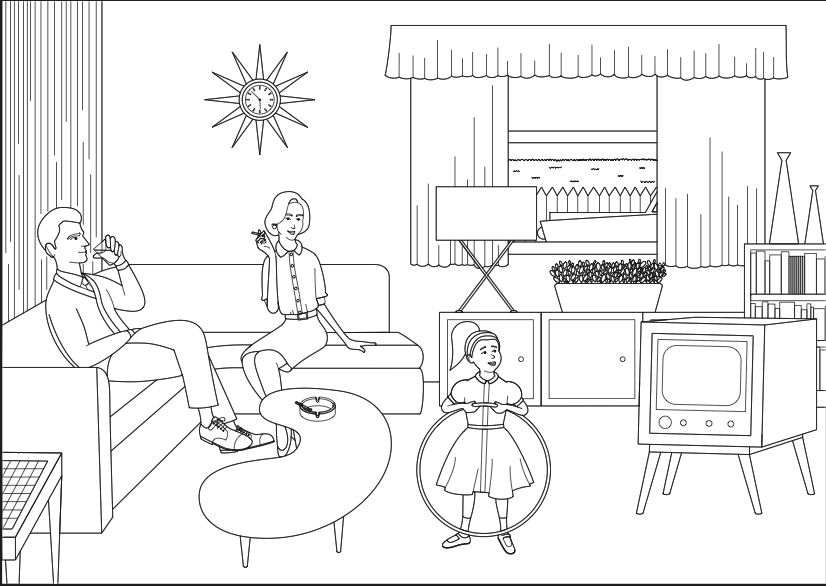
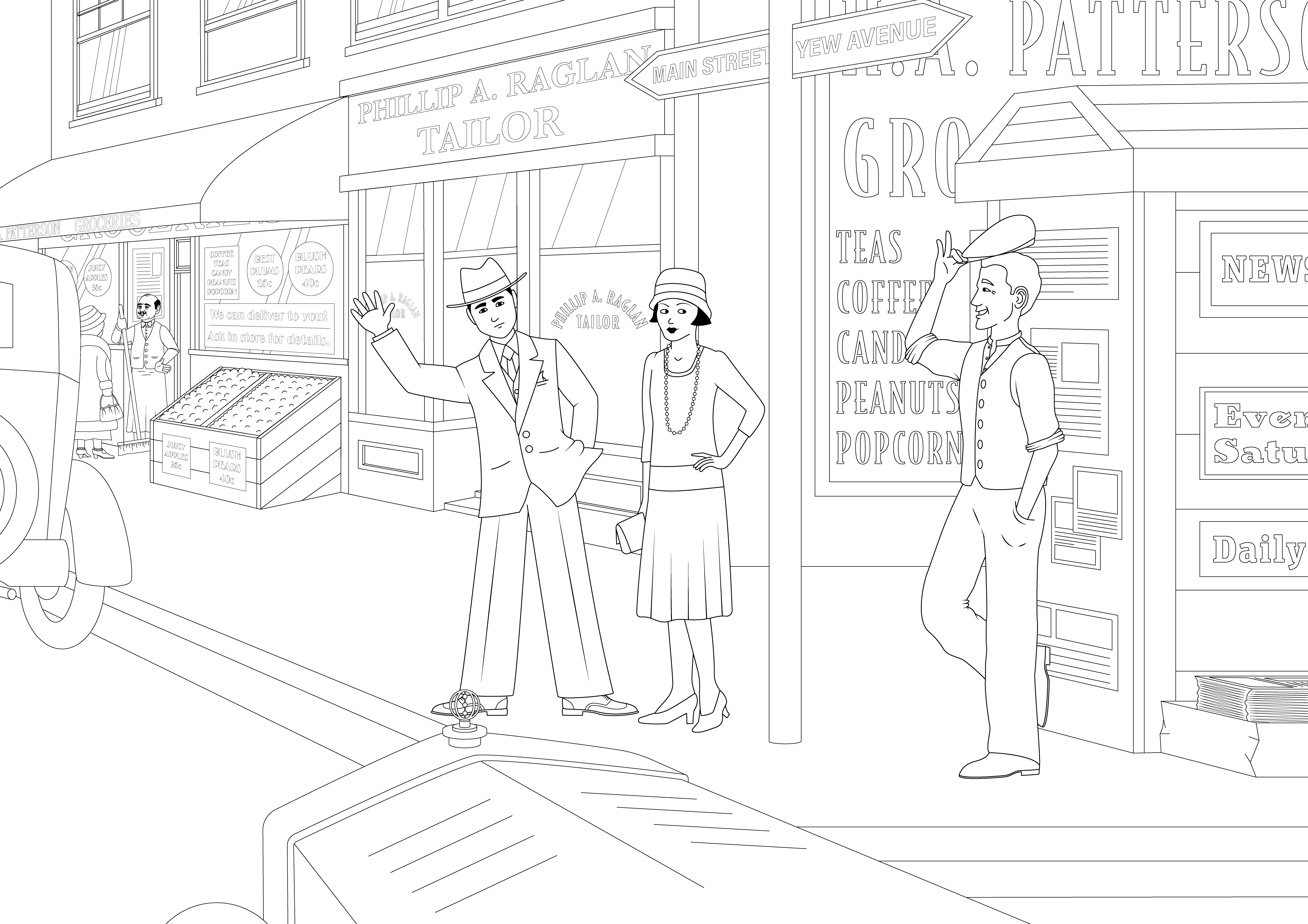
Reflection After Tutor Feedback
I thought my tutor raised an interesting point in the feedback regarding leaving detail out of the illustration, referring to the idea I had of adding a character in the upstairs window above the grocers.
This made me consider that perhaps a more intriguing narrative could be created by making the most important element of the drawing take place only partially revealed in the upstairs window. The viewer’s eye would only be drawn there after focusing on the three characters at the front of the composition in what appears to be a regular street from the 1920s. Completely unintentionally the raised hand of the man on the left of the trio is directed at the open window so could perhaps act as a visual clue and guide the eye there. Additionally the traffic is also moving in the direction of the window adding to this visual influence on the viewer.
In terms of what would be taking place in the upstairs room, a couple of ideas that sprung to mind could be two characters having an argument or activity that looks suspiciously gangster like (1920s style), it could even be connected to the couple hailing a cab – perhaps a gun aimed out of the window at them…in whatever case the view would only be partial and make the viewer want to know what is happening.
References
BBC Bitesize, (n.d.). The ‘Roaring Twenties’. [online] Available at: https://www.bbc.co.uk/bitesize/guides/zsggdxs/revision/1 [Accessed 6 August 2021].
BBC Home, (n.d.). 1920s. [online] Available at: https://www.bbc.co.uk/homes/design/period_1920s.shtml [Accessed 5 August 2021].
Brown, B. (2014). Snapshot: 21 Photos of 1920s London. [online} BBC America. Available at: https://www.bbcamerica.com/anglophenia/2013/08/snapshot-21-photos-of-1920s-london [Accessed 5 August 2021].
Chowdhury, D. (2020). 1920s Fashion for Women and Men. [online] Vintage Fashions. Available at: https://vintagefashions.co/1920-fashion-year-clothing-for-women-and-men/ [Accessed 6 August 2021].
Chowdhury, D. (2020). 1920s Men’s Fashion: A guide to men’s fashion history. [online] Vintage Fashions. Available at: https://vintagefashions.co/a-guide-to-mens-fashion-in-the-roaring-twenties/ [Accessed 5 August 2021].
Encyclopedia.com, (n.d.). 1920s: The Roaring Twenties. [online] Available at: https://www.encyclopedia.com/history/culture-magazines/1920s-roaring-twenties [Accessed 6 August 2021].
Ford, L. (2016). The 10 Most Influential Artworks from the 1920s and 1930s. [online] Culture Trip. Available at: https://theculturetrip.com/europe/united-kingdom/england/london/articles/the-10-most-influential-artworks-from-the-1920s-1930s/ [Accessed 5 August 2021].
GettyImages Gallery, (n.d.). 1920s. [online] Available at: https://gettyimagesgallery.com/collection/1920s/ [Accessed 5 August 2021].
Google Images Collection, (n.d.). 1920s reference images collection. [online] Available at: https://www.google.com/collections/s/list/W0I3lBw1QdqFhebaaGBkww/JxGFbOlPxH8 [Accessed 5 August 2021].
Johnson, B. (n.d.). The 1920s in Britain. [online] Historic UK. Available at: https://www.historic-uk.com/HistoryUK/HistoryofBritain/The-1920s-in-Britain/ [Accessed 5 August 2021].
Lewis, A. (2021). 100 Years Later, We’re Still Wearing Trends From This Decade. [online] Who What Wear. Available at: https://www.whowhatwear.co.uk/1920s-fashion [Accessed 6 August 2021].
Peregoy, B. (2016). 7 of the Best Art Deco Buildings in London. [online] Architectural Digest. Available at: https://www.architecturaldigest.com/gallery/art-deco-london [Accessed 5 August 2021].
Sessions, D. (2015). 1920s Fashion for Men. [online] Vintage Dancer. Available at: https://vintagedancer.com/1920s/1920s-fashion-men/ [Accessed 5 August 2021].
Wikipedia, (n.d.). 1920s. [online] Available at: https://en.wikipedia.org/wiki/1920s [Accessed 5 August 2021].
Wikipedia, (n.d.). Flapper. [online] Available at: https://en.wikipedia.org/wiki/Flapper [Accessed 6 August 2021].
